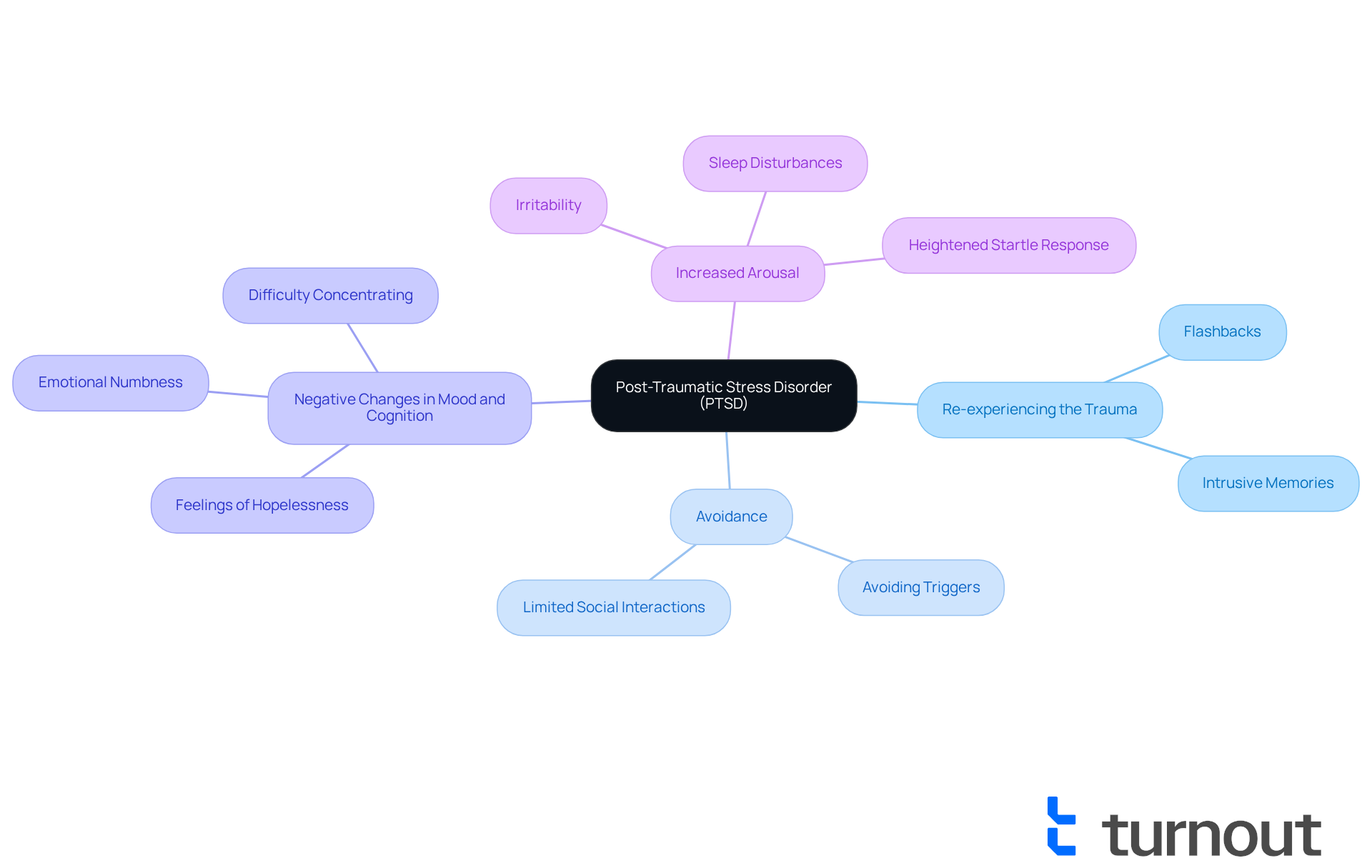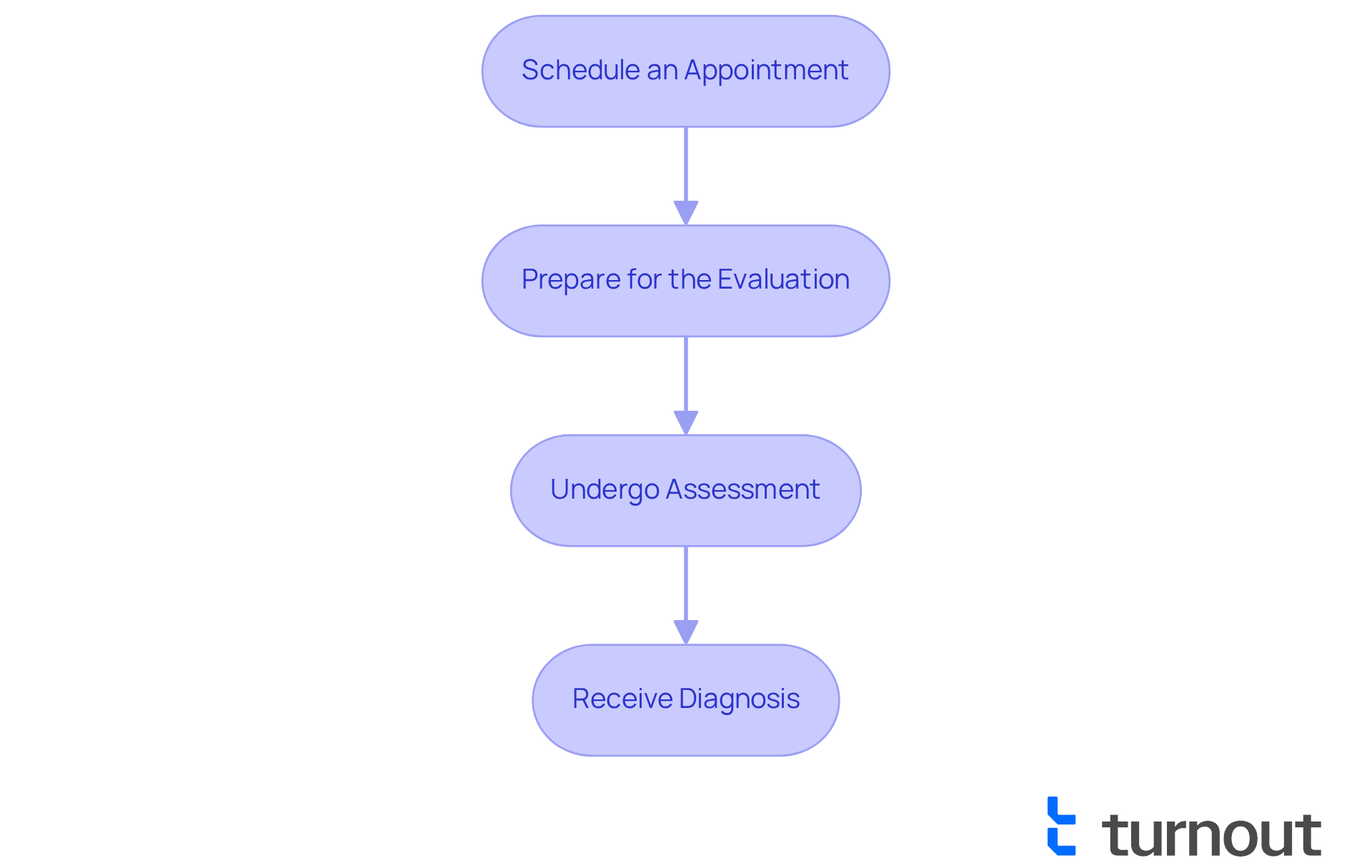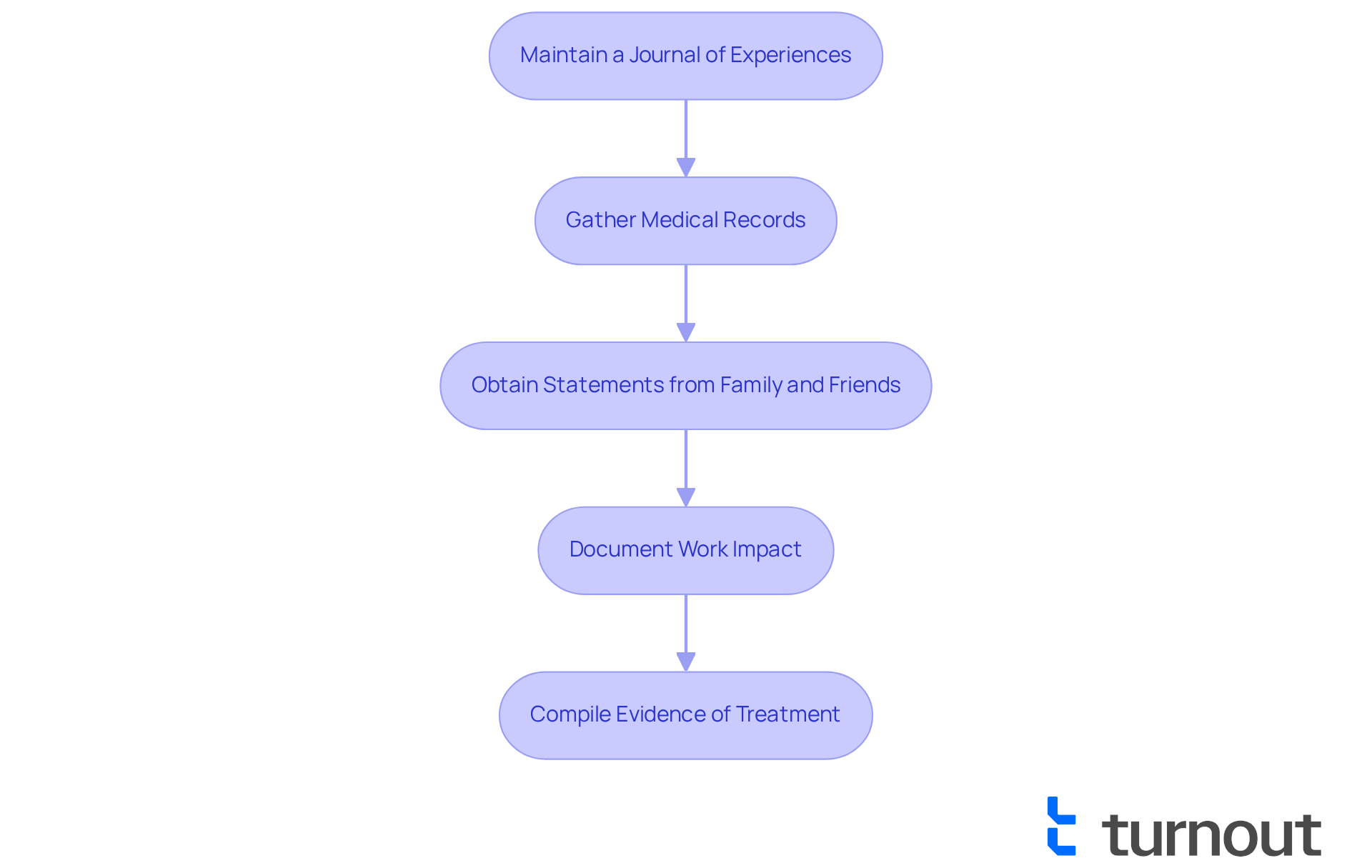Overview
Applying for Post Traumatic Stress Disorder (PTSD) disability benefits can feel overwhelming. We understand that taking this step requires courage and support. To begin, it's essential to obtain a formal diagnosis from a qualified mental health professional. This diagnosis is the first crucial step in your journey.
Next, it's important to meticulously document how PTSD affects your daily life and work capabilities. Comprehensive documentation is key. This includes:
- Keeping symptom journals
- Gathering medical records
Such detailed records help illustrate the severity of your condition and its impact on your functioning.
Remember, demonstrating how PTSD affects your life is critical for meeting the Social Security Administration's criteria. You're not alone in this process; many have successfully navigated these steps with the right support. We encourage you to take action and gather your documentation. You deserve the help you need.
Introduction
Navigating the complexities of post-traumatic stress disorder (PTSD) can feel overwhelming, especially when you're seeking disability benefits to support your journey. With around 3.6% of U.S. adults experiencing PTSD each year, understanding the application process for disability benefits is vital for many individuals looking to reclaim their lives. This guide outlines the essential steps to effectively apply for PTSD disability benefits, addressing common challenges while providing insights into how to document your symptoms and their impacts.
We understand that it can be difficult to ensure your application stands out in a system that often overlooks the significance of mental health conditions. You're not alone in this journey, and we're here to help you navigate the path ahead.
Understand Post-Traumatic Stress Disorder (PTSD)
Post-Traumatic Stress Disorder (PTSD) is a mental health condition that can arise from experiencing or witnessing a traumatic event. We understand that the symptoms can significantly affect your daily life and work performance. It’s crucial for applicants to express these effects clearly when applying for post traumatic stress disorder disability benefits. Turnout offers valuable tools and services to help individuals navigate the complexities of the Social Security Disability (SSD) claims process. Our goal is to ensure that you can effectively communicate how PTSD impacts your daily life and work capabilities. Please note that Turnout is not a law firm and does not provide legal advice.
Common symptoms of PTSD include:
- Re-experiencing the trauma: This may present as flashbacks or intrusive memories that disrupt daily activities.
- Avoidance: Individuals often steer clear of places, people, or situations that trigger memories of the trauma, limiting social interactions and opportunities.
- Negative changes in mood and cognition: Feelings of hopelessness, emotional numbness, and difficulty concentrating are prevalent, affecting personal and professional relationships.
- Increased arousal: Symptoms like irritability, sleep disturbances, and heightened startle responses can hinder your ability to function effectively at work.
Recognizing these symptoms is the first step in preparing for your application process. Comprehensive documentation of how post traumatic stress disorder disability benefits affect your everyday life and work abilities is essential for a successful claim. Research indicates that about 3.6% of U.S. adults encounter PTSD each year, with higher rates among women (5.2%) compared to men (1.8%). This highlights the widespread nature of this condition and its demographic differences. Mental health experts emphasize the importance of recognizing these indicators, as they can lead to significant challenges in various aspects of life, including job performance.
For instance, studies show that up to 50% of individuals undergoing treatment for PTSD experience significant symptom relief, showcasing the potential for recovery and improved functioning. Additionally, the stigma surrounding mental health issues can prevent individuals with trauma-related disorders from seeking necessary treatment. It’s vital to address these barriers when applying for post traumatic stress disorder disability benefits. Turnout's trained nonlawyer advocates are here to assist you in articulating these challenges effectively, ensuring you receive the support you need throughout the SSD claims process. Remember, you are not alone in this journey; we’re here to help.

Obtain a Formal Diagnosis of PTSD
Navigating the process of applying for post traumatic stress disorder disability benefits can feel overwhelming, but you're not alone. To begin, obtaining a formal diagnosis from a qualified mental health professional is crucial. Here’s how to approach this important step with care and support:
- Schedule an Appointment: Reach out to a psychologist, psychiatrist, or licensed mental health professional who specializes in trauma and PTSD. It’s essential to find someone who understands your needs.
- Prepare for the Evaluation: Before your appointment, take some time to reflect on your experiences. Be ready to discuss the traumatic events you've faced and how they affect your daily life. Keeping a record of your feelings and challenges can be incredibly helpful. Also, consider preparing questions for your healthcare professional about the assessment process, including what to expect and how long it may take.
- Undergo Assessment: During your evaluation, the specialist will conduct a thorough assessment. This may include interviews, questionnaires, and psychological testing, such as the Clinician-Administered Trauma Scale (CAPS). The evaluation can take anywhere from 15 minutes to 1-2 hours, depending on its complexity, but remember, this is a vital step in understanding your condition.
- Receive Diagnosis: If you meet the criteria for PTSD as outlined in the DSM-5—this includes experiencing at least one re-experiencing symptom, one avoidance symptom, two arousal and reactivity symptoms, and two cognition and mood symptoms—the professional will provide you with a formal diagnosis. Make sure to obtain a written report of this diagnosis; it is essential for your application.
Having a formal diagnosis is not just a formality; it validates your experiences and is a key component of your claim for post traumatic stress disorder disability benefits. It's important to know that approximately 6.8% of U.S. adults encounter PTSD at some point in their lives, which underscores the need for proper assessment and diagnosis. As Dr. Abigail Angkaw, a clinical psychologist, wisely states, "You can ask any provider. You can ask your primary care physician. You can even say, 'I'd like to be assessed for PTSD.'" Taking this proactive approach can significantly enhance your chances of receiving the support you need. Remember, we’re here to help you through this journey.

Document Symptoms and Impact on Daily Life
Once you have received your official diagnosis, the next step is to thoughtfully record your experiences and how they affect your everyday life. This documentation is crucial for your application. Here’s how to approach it with care:
- Maintain a Journal of Experiences: Take time to document daily occurrences related to your trauma-related symptoms. Note the frequency and intensity of indicators such as flashbacks, anxiety, and sleep disturbances. Research shows that many individuals with post traumatic stress disorder disability benefits who keep track of their experiences enhance their chances of a positive outcome.
- Gather Medical Records: Collect any medical records that detail your diagnosis, treatment history, and prescribed medications. This includes notes from therapy sessions and evaluations, which are essential for illustrating the severity of your condition.
- Obtain Statements from Family and Friends: Reach out to those close to you and ask them to provide written accounts of how your condition impacts your interactions and daily activities. Their observations can offer valuable context to your claim, highlighting the real-world effects of your symptoms.
- Document Work Impact: If applicable, keep records of how PTSD has affected your work performance, including any missed days, reduced hours, or changes in job responsibilities. This information is vital, as the Social Security Administration considers how your condition limits your ability to engage in substantial gainful activity, which is crucial for receiving post traumatic stress disorder disability benefits, defined as earning more than $1,620 per month for non-blind individuals in 2025.
- Compile Evidence of Treatment: Include any evidence of ongoing treatment, such as therapy sessions, medication management, or support groups. This shows your commitment to managing your condition and can strengthen your submission.
Comprehensive documentation will not only bolster your application but also help convey the seriousness of your situation to the reviewing authorities. Remember, simply having a diagnosis of a trauma-related disorder is not sufficient for post traumatic stress disorder disability benefits; your condition must meet specific severity criteria outlined by the SSA, requiring you to demonstrate 'extreme' limitation in one area or 'marked' limitation in two areas of mental functioning.
We understand that this process can feel overwhelming, but you are not alone in this journey. We’re here to help you every step of the way.

Complete and Submit Your Application Forms
Once you have collected all the necessary documentation, you are ready to finalize and submit your request for post traumatic stress disorder disability benefits. We understand that this process can feel overwhelming, but following these steps can help ensure a smooth experience:
- Choose the Right Application: Depending on your eligibility, you may need to fill out the VA Form 21-526EZ for VA disability compensation or the SSA-16 for Social Security disability benefits. Selecting the correct form is crucial to your success.
- Fill Out the Application: Carefully complete the application form, providing all requested information. Be thorough and truthful in your answers, especially regarding your health issues and their effects on your daily life.
- Attach Supporting Documents: Include all relevant documentation you have gathered, such as your diagnosis, symptom journal, medical records, and statements from family and friends. Organize everything clearly and label each document for easy reference. Ensure to include evidence that aligns with VA criteria, such as service records.
- Review Your Submission: Before submitting, double-check your documents for completeness and accuracy. Ensure that all required signatures are present and that your information is consistent throughout.
- Submit Your Request: Send your request via the appropriate method (online, by mail, or in person) as specified by the agency you are applying to. Remember to retain copies of everything you submit for your records.
- Follow Up: After submission, keep an eye on the progress of your request. It’s common to feel anxious during this time, so be prepared to provide additional information if requested by the agency. You can contact the VA benefits hotline at 800-827-1000 for assistance.
Finalizing and sending your request correctly is crucial for a favorable outcome. The typical processing duration for claims related to post traumatic stress disorder disability benefits can differ, often requiring approximately 103 days. Meanwhile, the VA claims procedure generally spans between 120-150 days. Keep in mind that frequent errors in submissions for post traumatic stress disorder disability benefits involve inadequate proof of symptoms and the inability to link the condition to service-related stressors. Investing effort to ensure your submission is comprehensive can greatly enhance your likelihood of acceptance.
For individuals navigating the SSD claims process, Turnout provides assistance through trained nonlegal advocates who can help you comprehend the requirements and ensure your submission is thorough. This approach allows you to receive guidance without the need for legal representation, making the process more accessible. Turnout offers tools and resources designed to simplify the application process, ensuring you have the necessary support every step of the way. Remember, you are not alone in this journey; we’re here to help.

Conclusion
Applying for post-traumatic stress disorder (PTSD) disability benefits can feel overwhelming, and we understand the challenges you may be facing. It's vital to acknowledge the significant impact PTSD can have on your daily life and work capabilities. By understanding the necessary steps—from obtaining a formal diagnosis to carefully documenting your symptoms and submitting a thorough application—you can navigate this complex journey with greater confidence and clarity.
Throughout this article, we've shared key insights on the importance of:
- Accurately portraying the effects of PTSD
- The necessity of thorough documentation
- The significance of choosing the correct application forms
The detailed steps outlined for:
- Obtaining a diagnosis
- Maintaining a symptom journal
- Compiling supporting evidence
highlight proactive measures that can significantly enhance your chances of a successful claim. Moreover, support from organizations like Turnout underscores the availability of resources that can assist you in articulating your experiences effectively.
Ultimately, your journey to securing PTSD disability benefits is not just about financial support; it’s a vital step toward reclaiming your sense of normalcy and well-being. We encourage you to take action by:
- Seeking professional help
- Documenting your experiences
- Utilizing available resources
By doing so, you can ensure your voice is heard, your challenges acknowledged, and your path to recovery supported. Remember, you are not alone in this journey; we’re here to help.
Frequently Asked Questions
What is Post-Traumatic Stress Disorder (PTSD)?
PTSD is a mental health condition that can develop after experiencing or witnessing a traumatic event. It can significantly affect daily life and work performance.
What are the common symptoms of PTSD?
Common symptoms include re-experiencing the trauma (flashbacks or intrusive memories), avoidance of triggers, negative changes in mood and cognition (feelings of hopelessness, emotional numbness, difficulty concentrating), and increased arousal (irritability, sleep disturbances, heightened startle responses).
How does PTSD affect daily life and work capabilities?
PTSD can disrupt daily activities, limit social interactions, impair personal and professional relationships, and hinder overall functioning at work due to its various symptoms.
What should individuals do when applying for PTSD disability benefits?
It is crucial for applicants to clearly express how PTSD impacts their daily life and work abilities. Comprehensive documentation of these effects is essential for a successful claim.
What percentage of U.S. adults experience PTSD each year?
Research indicates that about 3.6% of U.S. adults encounter PTSD annually, with higher rates among women (5.2%) compared to men (1.8%).
How can Turnout assist individuals applying for PTSD disability benefits?
Turnout offers tools and services to help individuals navigate the complexities of the Social Security Disability (SSD) claims process and assists in articulating the challenges posed by PTSD.
Is Turnout a law firm, and does it provide legal advice?
No, Turnout is not a law firm and does not provide legal advice.
What is the potential for recovery from PTSD?
Studies show that up to 50% of individuals undergoing treatment for PTSD experience significant symptom relief, indicating the potential for recovery and improved functioning.
What barriers might individuals with PTSD face when seeking treatment?
The stigma surrounding mental health issues can prevent individuals with trauma-related disorders from seeking necessary treatment, which is an important consideration when applying for benefits.




